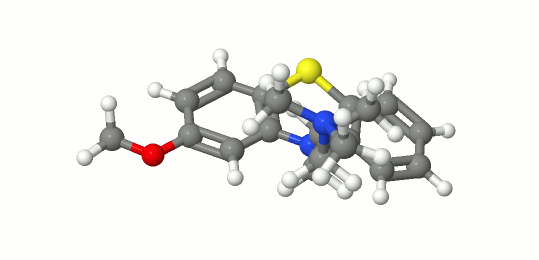Levomepromazine
 | |
 | |
| Clinical data | |
|---|---|
| AHFS/Drugs.com | Micromedex Detailed Consumer Information |
| Pregnancy category |
|
| Routes of administration | Oral, seldom intramuscular |
| ATC code | |
| Legal status | |
| Legal status | |
| Pharmacokinetic data | |
| Bioavailability | approx. 50 to 60% |
| Metabolism | Hepatic |
| Elimination half-life | ~ 20 hours |
| Excretion | In feces and urine (metabolites), unchanged drug only 1% |
| Identifiers | |
| |
| CAS Number | |
| PubChem CID | |
| DrugBank | |
| ChemSpider | |
| UNII | |
| KEGG | |
| ChEBI | |
| ChEMBL | |
| E number | {{#property:P628}} |
| ECHA InfoCard | {{#property:P2566}}Lua error in Module:EditAtWikidata at line 36: attempt to index field 'wikibase' (a nil value). |
| Chemical and physical data | |
| Formula | C19H24N2OS |
| Molar mass | 328.47 g/mol |
| 3D model (JSmol) | |
| |
| |
| | |
|
WikiDoc Resources for Levomepromazine |
|
Articles |
|---|
|
Most recent articles on Levomepromazine Most cited articles on Levomepromazine |
|
Media |
|
Powerpoint slides on Levomepromazine |
|
Evidence Based Medicine |
|
Clinical Trials |
|
Ongoing Trials on Levomepromazine at Clinical Trials.gov Trial results on Levomepromazine Clinical Trials on Levomepromazine at Google
|
|
Guidelines / Policies / Govt |
|
US National Guidelines Clearinghouse on Levomepromazine NICE Guidance on Levomepromazine
|
|
Books |
|
News |
|
Commentary |
|
Definitions |
|
Patient Resources / Community |
|
Patient resources on Levomepromazine Discussion groups on Levomepromazine Patient Handouts on Levomepromazine Directions to Hospitals Treating Levomepromazine Risk calculators and risk factors for Levomepromazine
|
|
Healthcare Provider Resources |
|
Causes & Risk Factors for Levomepromazine |
|
Continuing Medical Education (CME) |
|
International |
|
|
|
Business |
|
Experimental / Informatics |
Editor-In-Chief: C. Michael Gibson, M.S., M.D. [1]
Overview
Levomepromazine (INN, BAN, USAN), also known as methotrimeprazine (common use in America; sold as Nosinan, Nozinan, Levoprome) is an phenothiazine neuroleptic drug. It is a low-potency antipsychotic (approximately half as potent as chlorpromazine) with strong analgesic, hypnotic and antiemetic properties that is primarily used in palliative care.[1][2]
Serious side effects include tardive dyskinesia, akathisia, abnormalities in the electrical cycle of the heart, low blood pressure and the potentially fatal neuroleptic malignant syndrome.[1][2]
As is typical of phenothiazine antipsychotics, levomepromazine is a "dirty drug", that is, it exerts its effects by blocking a variety of receptors, including adrenergic receptors, dopamine receptors, histamine receptors, muscarinic acetylcholine receptors and serotonin receptors.[1][2]
Medical uses
Levomepromazine is used for the treatment of psychosis, particular those of schizophrenia, and manic phases of bipolar disorder. It should be used only with caution in the treatment of agitated depressions, as it can cause akathisia as a side effect, which could worsen the agitation.[1][2]
Levomepromazine is also used at lower doses for the treatment of nausea and insomnia.[1]
Levomepromazine is frequently prescribed and valued worldwide in palliative care medicine for its multimodal action, to treat intractable nausea or vomiting, and for severe delirium/ agitation in the last days of life. Palliative care physicians will commonly prescribe it orally or via subcutaneous syringe drivers in combination with more potent opiate analgesics such as Hydromorphone.[1][2]
Adverse effects
The most common side effect is akathisia.[2] Levomepromazine has prominent sedative and anticholinergic/sympatholytic effects (dry mouth, hypotension, sinus tachycardia, night sweats) and may cause weight gain.[2] These side effects normally preclude prescribing the drug in doses needed for full remission of schizophrenia, so it has to be combined with a more potent antipsychotic.[2] In any case, blood pressure and EKG should be monitored regularly.[2]
A rare but life-threatening side effect is neuroleptic malignant syndrome (NMS).[2] The symptoms of NMS include muscle stiffness, convulsions and fever.[2]
References
- PubChem Substance Summary: Levomepromazine National Center for Biotechnology Information.
- NOZINAN - Lévomépromazine Doctissimo Guides des Medicaments
- [2]Grampians Palliative Care Team Publication May 2010 (Victoria, Australia)
- [3] Palliative Care Guidelines, Scotland, UK
- Pages with script errors
- Template:drugs.com link with non-standard subpage
- Articles with changed DrugBank identifier
- Articles with changed EBI identifier
- E number from Wikidata
- ECHA InfoCard ID from Wikidata
- Chemical articles with unknown parameter in Infobox drug
- Drugboxes which contain changes to verified fields
- Drugboxes which contain changes to watched fields
- Drug
- Analgesics
- Antiemetics
- Antipsychotics
- Phenothiazines
- Phenol ethers